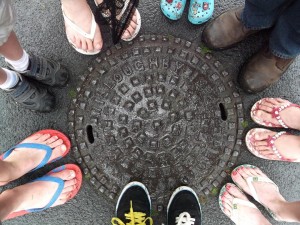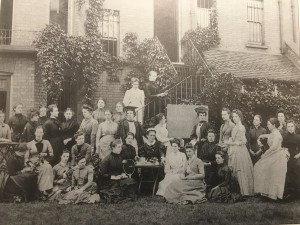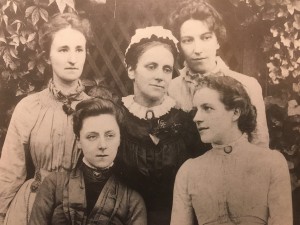
Josephine Willoughby (bottom left), with Constance Maynard (centre) and Frances Ralph Gray (bottom right)
Contrary to the popular view, the Suffragettes were not the only activists in the movement for female equality. Long before Suffragettism was at its peak in the early 1900s, other women had been making an often quiet and invariably courageous stand, particularly in the field of women’s education.
Of these, the best known are Emily Davies, the co-founder in 1869 of Girton College, Cambridge; her lifelong friend Elizabeth Garrett Anderson, who in 1865 was the first woman to qualify in Britain as a physician or surgeon; and Garrett Anderson’s younger sister Dame Millicent Fawcett, the suffragist (and opponent of the militant Suffragettes), who is considered instrumental in gaining the vote for six million British women over 30 years old in 1918.
According to the legend, it had begun with a momentous conversation one evening in 1860 at Alde House, the Garrett home near Aldeburgh. As Emily Davies and her best friend Elizabeth Garrett brushed their hair by the bedroom fire, the two young women had discussed their future lives, with Millicent, aged thirteen, observing silently. ‘Well Elizabeth,’ said Emily, ‘it is clear what has to be done. I must devote myself to securing higher education, while you open the medical profession for women. After these things are done we must see about getting the vote.’ She had then turned to the little girl, still sitting quietly on her stool. ‘You are younger than we are, Millie,’ she said, ‘so you must attend to that.’ (Jo Manton, Elizabeth Garrett Anderson (London, 1965), p.72.)
To women of less steely character, the barriers would have seemed insuperable. ‘The Victorian view of women,’ recalled a contemporary, ‘is that she was a creature born to please, whose personal individuality was strictly limited to, and by, this obligation. However politely expressed, it was a view in effect Oriental. Women were secondary adjuncts to the life of man … Woman’s destiny and sufficient purpose was to marry. Her education was directed to equipping her with graces and accomplishments calculated to attract a husband.’
This writer continues: ‘For “the average girl”, the “correct thing” was to be brought up at home.’ (Mary Agnes Hamilton, Newnham: An Informal Biography (London, 1936), pp.32, 47.) A clergyman’s daughter, Emily Davies had ‘learnt Latin with her brothers for her own pleasure and had written weekly English essays for criticism by her father. Yet she was forced to stay at home, her time frittered away in a multitude of small duties.’ Elizabeth Garrett Anderson had as her governess ‘a decayed gentlewoman’ who bored her rigid, followed by a few years at a private ‘Boarding School for Ladies’, the stupidity of whose teachers she remembered ‘with shudders’ (Manton, pp.32-4, 40). Even for the daughters – like her – of rich parents, the opportunities for secondary schooling were extremely limited.
Plymouth High School
It is perhaps not generally appreciated that the three renowned girls’ schools founded in the middle of the nineteenth century – Queen’s College, Harley Street (1848), North London Collegiate (1850) and Cheltenham Ladies’ (1854) – were ‘pioneering achievements’; that North London was ‘held up to scorn as a perilous innovation’; and that these were ‘tiny islands in the great sea’ (Hamilton, p.47). Fortunately, they were followed by an impressive number of similar foundations in the 1870s, particularly those of the Endowed Schools Commissioners and the Girls’ Public Day Schools Company, who between them had established, by 1880, some forty schools of the new type. St Leonard’s School, St Andrews, and Oxford, South Hampstead and Plymouth High Schools are worthy examples of these.
My great-grandfather’s elder sister, Caroline Annie Josephine Willoughby, born at Plymouth on 5 June 1863, was one of the original pupils at Plymouth High School (founded in 1874) and, for that reason alone, can be considered a pioneer in the history of women’s education. Of course this was made possible by well-to-do, liberal-minded parents who were not appalled by the prospect of their daughters’ being as well educated as their sons. Josephine had nine brothers and sisters, and the boys were all sent to Plymouth College, close to their home in Mutley, which, dating from 1877, is a slightly later foundation than the High School.
The father of this brood, Joseph Willoughby, was an engineer and iron founder, a long-standing member of the Town Council, and for fifty years the managing-director of Willoughby Bros. Ltd., from whose yards in Rendle Street were to emanate, in the 1890s and 1900s, such sturdy vessels as the Torpoint and Saltash chain-ferries; whilst man-hole covers in the Plymouth area are still stamped with their name. Joseph had married Ann Mason, a farmer’s daughter from Kenwyn, near Truro.
Newnham College, Cambridge
These paragons went even further, and placed themselves in a tiny minority even among the most enlightened parents. Realising that Josephine was just as clever as the most brilliant of her brothers, three of whom were to achieve doctoral degrees, they were prepared to support (in every sense) her continuing education at a university.
At Cambridge, there were now two colleges for women, who were allowed to pursue the same courses as the men and also to sit the Intermediate and Tripos examinations, though they were not permitted, as yet, to take degrees. The first of these women’s colleges was Girton, Emily Davies’s foundation of 1869. It was followed by Newnham, in the founding of which, in 1871, Millicent Fawcett had the guiding hand. Josephine was duly admitted to Newnham in 1882, to read Natural Sciences.
Her choice of college was surely influenced by her older High School contemporary, Frances Ralph Gray, who had preceded her there, whilst the presence of another Willoughby at the University – her first cousin Frederick, a second-year undergraduate at St Catherine’s – must have been reassuring for her parents. (Frederick was the son of her uncle Samuel, one of the partners in Willoughby Bros.) They were joined in 1884 by Josephine’s younger brother James, although he was to migrate after a couple of years at Selwyn Hall to Jesus College, Oxford. Both Frederick and James were marked out for clerical careers. Josephine’s youngest brother Willoughby (my great-grandfather) arrived at Caius much later, in 1894, also to read Natural Sciences and to launch himself on the brilliant medical career to which, in another age, Josephine herself might have aspired. (J. Venn, Alumni Cantabrigienses, I, ii, 4, pp.510-11.)
Predominant among Josephine’s contemporaries at Newnham were the daughters of intellectual families like those of Professors Skeat (the Anglo-Saxonist) and Rolleston (physiologist) and Longfellow (the American poet), mingled with those of enterprising business people like the Willoughbys themselves, the Colmans (mustard manufacturers of Norwich) and the Naishes (Wilton carpet manufacturers). The three Naish girls at Newnham were the sisters of William Vawdrey Naish of Emmanuel, later an M.D., who was to marry Josephine’s sister Madeleine. The aristocracy was represented too, in the person of Eva Knatchbull-Hugesson, daughter of Lord Brabourne and, appropriately, a great-grand-niece of Jane Austen. (Newnham College Register, 1871 – 1923 (1963), pp.65, 66, 72, 76, 77, 109, 121.)
Westfield College, London
Despite achieving a ‘First’ in the Natural Sciences Tripos in 1885, Josephine did not pursue the option of a medical career. Thanks to Elizabeth Garrett Anderson and the Medical Act of 1878, the profession was gradually opening up to women.
Instead, she was invited by Constance Maynard, its co-founder in 1882 and first ‘Mistress’, to join the staff of Westfield College for Ladies, the University of London’s equivalent of Newnham, whose premises were in Maresfield Gardens, Hampstead. The key recommendation was no doubt that of Frances Ralph Grey, her schoolfriend from Plymouth and forerunner at Newnham, who had herself joined the Westfield staff in 1883, as Resident Lecturer in Classics.
It seems that Josephine was initially appointed to cover for Katherine Tristram during her sabbatical. Constance Maynard documents their meeting in her intimate diary, which for the most part combines reflections on her rather oppressive spiritual life with her barely-suppressed lesbian yearnings. ‘May 31st 1885 – I went to Newnham & got Miss Willoughby to take Katie’s place for a year or two. It was not like getting Ralph. Gentle, guileless, good, I knew I cd live with her & work with her & be happy, yet it was not with the awe of a sudden inspiration. “Dove, I cd love you, if some day you will let me.” (Queen Mary, University of London Archives, MAYNARD PP7/1/20). In other words, Josephine would never be a substitute for Frances Ralph Grey, pointedly called ‘Ralph’ in the diaries, with whom Maynard appears to have been madly in love.
There were unseemly discussions about money, the miserly college council insisting that Josephine’s first term be unpaid; Maynard had subsequently to fight on her behalf for a salary (Pauline A. Phipps, Constance Maynard’s Passions (Toronto, 2015), p.136 and n.31). Her temporary position was, however, confirmed in 1887, when she was given charge of all the elementary teaching in Science for the B.Sc. degree, which accounted for about half the student body of thirty woman – for the progressive University of London, unlike Oxford and Cambridge, had been allowing women to take its degrees since 1878.
The teaching staff at that time consisted of six women, all but one of whom were ‘Resident Lecturers’. They lived in a genteel maternal atmosphere, waited on by servants, dressing formally for dinner and observing rituals such as afternoon tea (Phipps, p.128). Josephine was to reside at Westfield for a total of nine years, but her own inclinations were to marriage and she became engaged in 1888 to William Adams Clark, a fellow medical student of her brother George at Bart’s. Their wedding was inevitably deferred until the time when he was fully qualified.
Within a couple of years, Josephine had made herself indispensable at her college, and was considered ‘the great authority on all practical matters: it was to her, for example, that the heating engineer explained the hot water system of the “New Westfield” – the College’s expanded premises on Kidderpore Avenue, West Hampstead – “pouring facts upon her which she absorbed with the intuition of a true genius” (Constance Maynard’s Diary February 1891, quoted in Janet Sondheimer, Castle Adamant in Hampstead (Westfield College, 1983), p.31). She was also remembered as ‘the organiser of an annual river picnic for Matriculation candidates, to which her fiancé bought some of his fellow medical students’ (ibid.).
It was therefore a great loss to the college (and a personal tragedy for Maynard, who was heartbroken) when ‘Ralph’ and Josephine both departed in 1894, Miss Gray to become a headmistress and ultimately the High Mistress of St Paul’s Girls’ School in London, Josephine to married life with William Adams Clark, now an M.D.
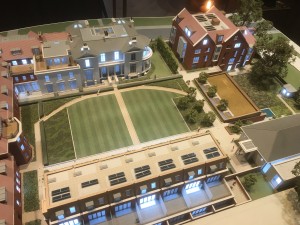
A model of the new Westfield development shows 'Willoughby' at top right, facing onto Kidderpore Avenue. To the left is Kidderpore Manor, which is to be sold as a single dwelling
Their wedding took place on her thirty-second birthday, 5 June 1895, after which they settled, improbably, in unglamorous Penge, with William in general practice in the High Street, and Josephine, equipped from 1896 with the Society of Apothecaries’ Assistants’ Certificate, as his partner in all but name, dispensing medicine and performing unofficially all the functions of the modern general practitioner. She had a son and two daughters, one of whom, Dora, was to qualify as a doctor. After a reunion of the original Westfield staff in 1905, Maynard aptly described her appearance as ‘motherly’ (Phipps, illustration p.192). She died on 15 August 1945.
Josephine Adams Clark, who was finally conceded her M.A. from Cambridge in 1923, would have thought herself in no way a revolutionary or even have described herself as a ‘feminist’ – pictured at my grandparents’ wedding, the couple appear highly conventional, Uncle William resplendent in his silk ‘topper’ – though it is women such as she who have made possible the education of women on equal terms with men.
A particular beneficiary is my own daughter, Josephine’s great-great-grand-niece, who has recently been offered a place at Westfield’s successor college, Queen Mary. I myself, though a member of another college, attended courses at Westfield in the late 1980s, unaware of the family connection, and can attest to the maternal atmosphere that still prevailed there. In what by then was a mixed college, the men on the Medieval History courses were a distinct minority, but the feminine preponderance was very enjoyable, and they all seemed to live as a close and cheerful family, carefully overseen, and organised on weekend activities and trips, by their equivalent of a Resident Lecturer, the redoubtable Brenda Bolton.
I was saddened less by the college’s merging with Queen Mary in 1989 than by the abandonment of the Hampstead campus in 1992. King’s College now uses some of the buildings. The least attractive teaching blocks have made way for the ‘Westfield Apartments’, a complex of luxurious flats. To our delight, part of it, between Kidderpore Hall and St Luke’s Vicarage, whose later occupant, coincidentally, was Josephine’s brother James, is to be known as ‘Willoughby’ in Josephine’s honour (https://www.mountanvil.com/our-london-homes/hampstead-manor/about-hampstead-manor/history/).
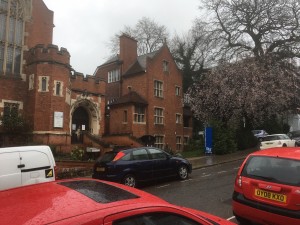
St Luke's Vicarage, Kidderpore Avenue, was later occupied by Josephine's brother James. It is flanked by St Luke's Church and (behind the trees) by the building that is to be named 'Willoughby' in her honour
[See also http://library.qmul.ac.uk/media/library/archives/diary/Green-Book-Diary,-3-January-1885—12-August-1887.pdf – Constance Maynard’s diaries online – and http://www.library.qmul.ac.uk/archives/archives-chronology/westfield-college/ – historical information from the college. Comments are welcome, but please notify the administrator at rupertwilloughby@btinternet.com, to spare him from sifting through the abundant ‘spam’.]
